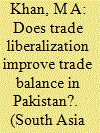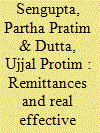|
|
|
Sort Order |
|
|
|
Items / Page
|
|
|
|
|
|
|
| Srl | Item |
| 1 |
ID:
157061


|
|
|
|
|
| Summary/Abstract |
This article examines the impact of trade liberalization, that is, reduction of tariff and non-tariff barriers on trade balance, in Pakistan over the period 1982–2013. The results reveal that reduction of average effective tariff rate improves trade balance in the short run, while lowering of non-tariff barriers deteriorates trade balance in the long run as well as in the short run. The analysis also suggests that depreciation of real effective exchange rate and foreign income causes an improvement in the trade balance, whereas domestic income deteriorates it. The negative association between the reduction in non-tariff barriers and trade balance worsens sustainability of current account of the balance of payments in Pakistan.
|
|
|
|
|
|
|
|
|
|
|
|
|
|
|
|
| 2 |
ID:
122948


|
|
|
|
|
| Publication |
2013.
|
| Summary/Abstract |
This paper measures the industry-specific real effective exchange rate (REER) for China by matching domestic and foreign industry-level price and trade data series. We find that after 2005 the REER appreciates more in the "chemical, plastics, rubber and fuels industry" and the "machinery and equipment industry," but remains roughly constant or even depreciates in other industries. The nominal exchange rate generally accounts for over 50 percent of the aggregate real effective exchange rate fluctuations, but this conclusion does not apply to three of nine industries. We apply the industry-specific REER to re-examine the relationship between the exchange rate and trade, and find that the industry-specific REER index performs better than the traditional aggregate REER index. We recommend that the Chinese Government officially adopt industry-specific exchange rates instead of using the aggregate effective exchange rates to evaluate the competitiveness of Chinese industries in the international market.
|
|
|
|
|
|
|
|
|
|
|
|
|
|
|
|
| 3 |
ID:
187892


|
|
|
|
|
| Summary/Abstract |
Using a novel panel data method proposed by Hisao, Ching and Wan (2012), we empirically evaluate the misalignments between the actual and counterfactual values of Chinese real effective exchange rate (REER, CPI-based) from 1994 to 2020, where “counterfactual” refers to the counterfactual scenarios that some major economic events had not happened. These events include China's accession to WTO from December 2001, the reforms of exchange rate regime in July 2005, June 2010 and August 2015, China's economic stimulus package in November 2008, and the US-China trade dispute started from March 2018. We calculate the counterfactual values for both real and nominal effective exchange rates (REER and NEER) in order to examine the channels of the misalignments. We find that the reform of China's exchange rate policy in July 2005 and August 2015 increased Renminbi's trade competitiveness in real term compare to foreign currencies, while other events decreased it or had no effects. The misalignments in REER are caused by the changes in both NEER and China's CPI.
|
|
|
|
|
|
|
|
|
|
|
|
|
|
|
|
| 4 |
ID:
148693


|
|
|
|
|
| Summary/Abstract |
Using data for the period 2000–2011, we construct province-level real effective exchange rate (REER) indices for China and test the effect of REER depreciation on regional economic growth in a generalized method of moments regression framework. Our results show that REER depreciation, in general, promotes regional economic growth, through increasing net exports and lowering FDI costs. After dividing the full sample into coastal and inland subsamples, we find that REER depreciation influences economic growth in inland areas but not in coastal areas. This is due to the fact that the inland areas have more surplus labor or other resources to expand their production capacity when REER depreciation leads to increased world demand. Furthermore, compared to inland areas, processing-and-assembly trade comprises a larger share of trade in the coastal areas, where traders import more raw materials and intermediate goods to process and assemble goods. When the exchange rate depreciates, the costs of imported materials and immediate goods increase. In this case, the benefits from REER depreciation in coastal areas are offset to some extent and are thus lower than in inland areas.
|
|
|
|
|
|
|
|
|
|
|
|
|
|
|
|
| 5 |
ID:
159810


|
|
|
|
|
| Summary/Abstract |
Remittances in India have been growing rapidly since 1991. Most of the studies find that remittance has had a significant impact on real effective exchange rate (REER). It is imperative to evaluate the impact of a transfer such as remittance and aid on country’s competitiveness. This article is an attempt to investigate the impact of workers’ remittances and some selected macro-variables on REER of India using annual data from 1980–2015. The study conducted autoregressive distributive lag (ARDL) bound test co-integration approach to explore this long-run relationship. The ARDL bound test approach confirms significant long-run relationships among the selected variables at 1 per cent level of significance. In addition to this, the ARDL short-run error correction model implies that while REER may temporarily deviate from its long-run equilibrium, the deviations adjust towards the equilibrium level in the long run.
|
|
|
|
|
|
|
|
|
|
|
|
|
|
|
|
|
|
|
|
|